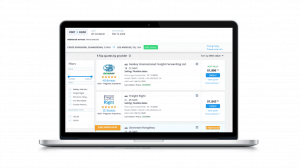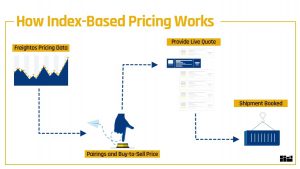COVID-19 has seriously disrupted the global supply chain.
But one positive aspect of the interruptions to business as usual may be an adrenaline shot to freight digitization.
The outbreak spurred companies like ZIM, Kuehne+Nagel, and Maersk to roll out new tools that could smooth logistics during the crisis. Not to mention that awareness and expectations of the need for more tech in the industry were also piqued.
Index-linked spot pricing is another recent innovation that is helping freight forwarders (and shippers) remain agile in this fast-changing reality.
As we’ll see, automating pricing can improve logistics providers’ conversion rates by increasing the number of port pairings offered, and instantly provide quotes to customers. It can also change when and how forwarders negotiate rates with carriers, creating new leverage and opportunities for profit. For shippers it can provide transparency as to how much they are paying and why.
Need an Index Linking Refresher?
Ocean Spot Status Quo
Let’s take a step back.
The way most forwarders currently provide customers with spot quotes is time consuming, resource heavy, and unreliable.
Forwarders receive a weekly directory of spot rates from carriers in Excel or PDF, detailing the price to ship containers between a long list of port pairings. When a customer requests a quote for a given origin and destination, the forwarder needs to consult the lists, and compare carrier rates. Often, forwarders will then reach out to more than one carrier and try to negotiate a discount on the listed rate.
Once the carrier and forwarder agree on a price, the forwarder has to decide on the size of the margin to add, and then send that quote to the customer.
This process takes time.
Recent research found that freight forwarders take an average of five days to respond to an online request for a quote, and while the customer is waiting, they are often shopping around to other forwarders to try and find the best rate.
Not to mention that even once the forwarder returns the quote, more time is often needed for forwarder-customer negotiations, with the customer only accepting the final quote about 20% of the time.
So the forwarder in effect spends a lot of its sales team’s time and effort on procuring spot rates that often are not booked.
And of course, if a forwarder wants to leverage digital sales channels that provide rates to customers instantly, they need to decide which port pairings to quote ahead of time, and set rates for each in advance – and all of the above energy needs to be expended on rates that may not even be requested, let alone booked.
So currently, to get a spot quote, the shipper suffers from slow, unreliable service and price opacity, and the forwarder spends time and energy procuring rates and producing quotes that often won’t result in a sale.
Enter digital innovation: Index-linked spot sales
Automating quotes through a reliable index lets forwarders generate a reliable, competitive quote requiring zero time or effort. And it gives shippers an instant and fair quote.
But first you need a reliable index.
Enter, the Freightos Baltic Index (FBX), which is based on millions of real-world, real time global container pricing points, and is the world’s first daily, audited and benchmark-compliant ocean freight index.
Get Free Access to the Freightos Baltic Index
The FBX reports daily benchmarks rates for a selection of major trade routes by bundling data on multiple origin and destination ports from key regions into a series of indexed lanes.
But those same thousands of data points can be broken down to the level of individual port pairings, creating a benchmarked, index-based rate for any given origin-destination combination that a customer requests.
The concept of automated index-linked rates in ocean freight is new, but how it’s done and whether forwarders can benefit from it have already been tested.
This case study details how one freight forwarder used index-linking to automate spot rates with confidence that the prices reflect the reality in the market.

What they discovered was that instead of spending time deciding which rates to publish online, or negotiating rates with carriers for quotes that might not get booked, their sales team was able to focus on negotiating the most profitable bookings with carriers, bringing their “cost of quoting” to zero.
It also resulted in their ability to:
- Return quotes to customers instantly.
- Increase their geographical spread by offering accurate prices for more port pairings at zero additional cost.
- Be more aggressive in negotiating bookings with carriers, and
- Close more business because of the increase in the volume of quotes they could provide.
What follows is a review of one freight forwarder’s success providing index-linked quotes on Freightos.com’s digital marketplace. Index-linking could just as easily be used to enable instant quoting and digital sales on a forwarder’s own portal, or as a back office quoting tool.
How ECU Worldwide Tapped Index-linked Spot Sales – A Case Study
Following a successful, first-of-its-kind pilot in 2019, global logistics provider ECU Worldwide has been using and benefitting from index-linked rates for its FCL quotes on the Freightos.com marketplace since early 2020.
ECU Worldwide had been selling on the Freightos.com marketplace since early 2019. Spencer Strader, Director of Imports for ECU Worldwide USA, who spearheaded this initiative, explained that ECU had been focused on LCL shipping for its US imports service. It wanted to extend the benefits of selling through a digital platform to FCL, but had less confidence in pricing the new product.
After comparing Freightos’ historical rate data for 50 North American trade lanes to ECU’s actual costs, ECU was confident that the index would reflect the actual market and be a reliable basis for ECU’s sell rates.
Fast, Competitive, Customizable Rates and Plenty of Them
Even in this automated environment though, index-linking still left ECU with control over how competitive it wanted its quotes to be and the flexibility to customize rates for different shipment and customer types.
For each port pairing, ECU could choose among the higher or lower percentile rates used to calculate the benchmark, and decide whether to be more expensive, more competitive, or close to the mean (as well as what margin to build in) in their automated rates.
Rates could also be set to adjust for different load sizes or add a markup or markdown to the sell value under certain predefined scenarios.

In an industry often plagued by slow or low responsiveness to customers, ECU’s automated rates guaranteed that all their customers instantly received a response to their quote requests.
They also let ECU significantly improve its geographic coverage: using index-linked rates, ECU was able to provide pricing for over 9,200 different port combinations for 77 different trade lanes at no additional cost, which Strader describes as “another big win for us.”
Lower Cost to Sell, and New Leverage in Negotiations
In ECU’s experience, though, the biggest advantage is that the quote procurement component of ECU’s cost to sell has dropped to zero.
Strader explained that the process was simplified. “By essentially outsourcing rate procurement I don’t have to spend resources, time and energy procuring and negotiating to get a cost on business I don’t have.”
This shift in how the sales team was being used also changed the way they could go about actually procuring shipments. It allowed the team to focus on negotiating rates for actual bookings with the carriers, and to be more aggressive in doing so.
“Index-linked rates opened our eyes to the ability to quote to a client without being tied to a specific carrier – I can quote just a rate and a transit time.” Strader continued that without being tied to a specific carrier “I can [take that booking from a customer], go to the spot market and negotiate with five different carriers to push that rate down even more depending on which carrier is light and so on, to find further savings and make that index rate more profitable and the space more secure.”
Beginning negotiations with a shipper’s booking already in hand often created leverage for ECU over the ocean carriers that previously didn’t exist.
More Bookings, Better Profitability
The combination of more coverage, instant quotes, and the shift of the sales team from rate procurement for quotes to booking procurement added up to an improved bottom line.
The better coverage and speed of quoting lead to an improved conversion rate and a sharp increase in monthly FCL revenues. ECU gross bookings on the marketplace increased five-fold in the first two months of the pilot.
“The results from the pilot were fantastic,” Strader continued. “Eighty-percent of our files were profitable. My staff loved it, as now they can spend time and energy procuring on actual bookings which was a brand new experience for us. It was great. I think index-linking is the future.”
And based on the pilot results, ECU became the first marketplace seller – and possibly the first freight forwarder in the industry – to leverage digital index rates to change how they do business and benefit as a result.
Just the Beginning
Even within index-linked spot sales, the ECU experience is only one example of how linking rates to an index can benefit the industry.
In an industry sometimes plagued by price opacity, forwarders who market their rates as index-based can give shippers the benefit of increased confidence in the fairness and reliability of the quote.
But beyond providing transparency and building trust, index-linking could streamline the entire process of spot bookings.
Forwarders could offer shippers a “spot-sales contract” stipulating that all spot bookings for the duration of the agreement would be based on the index rate for the given port pair plus/minus a negotiated percentage. Shippers could even approach forwarders with the same type of proposal.
These contracts could resolve other industry problems too.
Sometimes, carrier rates increase after the customer has booked with the forwarder, but before the forwarder has booked the shipment with the carrier. These increases are often passed on to unhappy shippers who thought they had already agreed on a rate.
But by setting the shipment’s price as the index rate on the order’s actual “gate-in” date, these contracts could remove this pain point as well.
These types of arrangements could eliminate the need for quoting and for negotiations between forwarders and shippers every time a spot booking was necessary, and could also build customer loyalty by reducing or eliminating the need for shippers to shop around.
And spot sales is just one example of how a digitized index can lead to new forms of efficiencies and transparency in freight.
Index-linked long term freight contracts, like those already used in BAF agreements and bulk contracts, could reduce the complexity of negotiations between BCOs, forwarders and carriers, could extend the contract duration eliminating the time expense of annual renewals, and allow hedging and volatility risk to be managed through index-linked derivatives.
Leveraging data made available through digitization is one sign of a digitally mature industry. Index-linked sales is one example of logistics’ steps towards digital freight, and it’s just the beginning.



